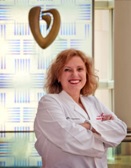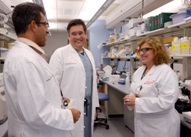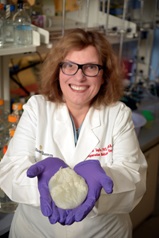Healing hearts and women in STEM: an interview with Doris A Taylor

In this interview, Dr Doris A Taylor, Director of Regenerative Medicine Research and the Center for Cell and Organ Biotechnology at the Texas Heart Institute (TX, USA), discusses her career to date and experiences as a woman working in STEM.
Inspired by International Women’s Day 2016, we are interviewing Dr Doris A Taylor, a leading expert and pioneer in heart regeneration, on her career to date and experiences as a woman working in science.

Doris A Taylor, PhD, DSc (hon), FACC, FAHA
Director, THI Regenerative Medicine Research, Texas Heart Institute
Director, Center for Cell and Organ Biotechnology at the Texas Heart Institute and TAMU College of Veterinary Medicine
Adjunct Professor, TAMU College of Veterinary Medicine, Dept. Veterinary Physiology and Pharmacology
Adjunct Professor, Rice University Department of Biochemistry
As a pioneer in cardiovascular cell therapy research, Dr Taylor is credited with a number of important scientific breakthroughs related to cell therapy, stem cell biology and tissue engineering. She holds a number of invention disclosures, patent applications and patents, and is the founder of multiple companies dedicated to cardiovascular repair technologies. She is a member of the Society for Women’s Health Research (SWHR) Cardiovascular Working Group and the Organization for the Study of Sex Differences (OSSD). Other professional affiliations include the American Association for the Advancement of Science (AAAS), the American Heart Association (AHA), and the Federation of American Societies for Experimental Biology (FASEB), among others. She was recently appointed to the Executive Committee for the Alliance for Regenerative Medicine (ARM), and also has appointments as a Fellow for the AHA, the Council on Functional Genomics and Translational Biology, the American College of Cardiology, and the Council on Basic Cardiovascular Sciences. She also has been recognized by the AHA for Top 10 Research Advances.
First of all, can you tell us what led you to work in the field of cardiac regeneration?
Originally I actually wanted to learn about differences between the mind and brain, but I ended up in a muscle lab. During that time, one of my professors at UTSW told me something that stuck with me — that I was the type of person that could run my own lab. This is also where I met Dr James T Willerson, our current president at the Texas Heart Institute and a visionary in heart and vascular research. I have always enjoyed developing new techniques and searching for answers to questions — what I called “renaissance” science — and eventually that led me to cardiac regeneration. The ultimate challenge in medicine is building a heart and regenerating lost function.
What is a typical day in your job like?
When you are a scientist pursuing new ideas in an emerging field like regenerative medicine, there is no typical day. My work is highly collaborative both nationally and internationally, and this requires intense coordination, scheduling challenges and constant prioritizing. There are days I am in back-to-back-meetings from 6:00 AM to 9:00 PM, and others when I’m focused on writing and editing manuscripts or protocols over a pot of coffee. But the best days are those with my team in the lab. I made sure to build my office at the Texas Heart Institute in the corner of my lab, which has plenty of windows from section-to-section, so I could spend as much time there as possible to observe and analyze our progress.

You largely work in bioengineering hearts. Do you feel this is more promising approach to heart regeneration than cell therapies or seeking to activate endogenous stem cells, or are they all valuable methods to continue investigating, at present?
Half of my lab is focused on building a heart, but the other half of my lab is focused on profiling stem cells from people with disease to develop new therapies and diagnostics. While I personally view building a complex organ like the heart as the ultimate challenge, all solutions warrant investigation in parallel. According to the World Health Organization, the total number of deaths worldwide due to cardiovascular disease has reached 17.3 million a year. Each of these methods may be necessary for the ultimate clinical response needed to help patients with this disease.
You and your labs have achieved some amazing results like successfully created beating hearts using stem cells. What would you say has been your greatest career achievement so far?
My greatest achievement has been making my family, in particular my mom, proud. Scientifically, it was helping create two fields — stem cell therapy for heart disease and tissue engineering of complex organs. Being in the operating room when one of the first patients was receiving stem cell therapy, back in 2000, was amazing.

You have looked at the difference in men versus women’s stem cells. Why did this arise as a question, and what were the results?
The occurrence of coronary artery disease differs in males and females–beginning sooner in males, with “catch-up” occurring in females by the 8th decade. I strongly believe a better understanding of sex and functional differences in cardiac stem cell types could lead us to develop sex-specific strategies that afford major advances in the treatment of cardiovascular diseases.
Our group has already begun to profile sex differences in progenitor cells in the blood of men and women with plans to expand on this work. As for preliminary results, in a mouse model we found important sex differences in the repair of atherosclerosis, which involves differences in both the stem cells present and the cytokines produced. We have also observed that the loss of stem cells occurs with aging and differs by sex–dropping faster in men than in women. We were able to show that loss of a particular bone-marrow-derived angiogenic stem cell population, CD34+ cells, decreases with age differently in males than in females, and in a manner that inversely correlates with the progression of atherosclerotic disease. Our studies have also shown that bone-marrow-derived mononuclear cells from males and females present distinct atheroprotective capabilities in a mouse model.
Additionally, we have early clinical work that suggests the composition and potency of stem cells in the bone marrow of men and women differ. The data suggest that women’s cells are more reparative and may reflect a difference due to the need for a tempered immune response during pregnancy. In other words, women rock!
All jokes aside, based on these observations, I believe cell therapy is not a regenerative strategy simply because cells can integrate into injury sites and participate in new tissue formation, but also because these cells can shift the recipient’s balance away from an inflammatory injury state, toward a condition that is more anti-inflammatory and reparative.
What is it that motivates you in your career, to get through the days when then experiments don’t work and try again the next day, etc.?
Some days it’s as simple as exciting conversations with my staff. But primarily it’s knowing we are trying to make a difference in the world — millions of people are counting on us to discover solutions. And that means we have to be in it for the long haul. If it were easy, everyone else would do it. There’s a quote from Gandhi on my wall that I visit often. “First they ignore you, then they laugh at you, then they fight you, then you win.” It helps.
Did you have much support or any role models as a student or early-career bioengineer?
I was fortunate to learn how to think as an undergraduate. I was very curious in my early twenties and had amazing professors at this critical time in a college student’s life. They exposed me to sophisticated thinking skills, encouraged me to question and challenge, and these things benefitted me greatly in graduate school.
Also, I was surrounded by MANY strong women who became role models. Nora Howell, my physiology professor at Mississippi University for Women, encouraged me to be a scientist. Dr Leslie Leinwand, my professor and mentor at Albert Einstein College of Medicine, taught me how to be a woman in science and how to do it well. Ann Richards, the former Governor of Texas, is another woman I took inspiration from. And before all of this, it really started with reading biographies of strong women, like Anne Sullivan, Helen Keller, Rosa Parks and some Laura Ingalls Wilder, too.
All of these early experiences afforded me a level of empowerment that I carry with me today and try to impress on my team.
Have you ever in your career to date felt that you were at a disadvantage owing to your gender?
Power dynamics are a part of any field, and that is certainly true in science and medicine. While I might not say “disadvantaged,” I think underestimated is accurate. I always encourage every woman to read two books: “The Art of War” to learn how to strategize, and “Nice Girls Still Don’t Get the Corner Office” to learn about unconscious ways that our socialization as girls and theirs as boys may lead us to nonverbally communicate and be perceived differently than we think we are.
Did you notice any difference in opportunities available to women or in how you were treated as you gained more senior academic positions?
The opportunities for women are available, but women do not always pursue them as aggressively. I realized early on that no one was going to manage my career for me and I sought mentors along the way. I cannot stress enough the importance of taking responsibility for your own professional advancement. At the same time, most successful women I know have had a male advocate. Find a mentor who has done it and learn from them.
Another thing I’ve recognized is that, to many of us women, negotiation is personal. You are putting yourself and your worth in the conversation. My male colleagues tell me it’s more of a competition. We have to learn how to fight the good fight and not make it a personal one when negotiating. This is important because negotiation is key in senior roles.
I also believe women often have more demanding roles and responsibilities in their personal lives, and this can present challenges as you move into more senior academic positions. However, it can be done. There are amazing women holding very senior academic positions, as well as executive level leadership, in our 56 Texas Medical Center academic institutions alone.
How do you achieve that balance between your work and your life and family?
Sometimes I don’t. This is a challenge for everyone and requires planning and prioritizing. You must approach your family life like you approach your work. I schedule my weekends and evenings as I do my days, and I protect my time with family. Sometimes you have to make exceptions when there are deadlines. However, for the most part, I believe you can strike a healthy balance. It’s about choices, really, and you must guard your time and manage it actively and aggressively. Luckily, in today’s digital world, we have the tools to help manage our calendar at our fingertips.
Are there any female colleagues you particularly look up to or are inspired by?
In addition to the role models I mentioned from earlier on in my career that inspired me at a young age and continue to do so today, I would be remiss without mentioning my mom, Julia Taylor. And there are others. Nanette Wenger is amazing. She’s smart, strategic, caring, a great leader and really one of a kind. I couldn’t ask for a better role model. Also, Noel Bairey Merz who really has done it all, and Dr Paula Douglas who just continues to amaze me.
Is there any equality outreach work you do, and if so what does it entail?
I am a strong believer in social justice and believe we are all in this together. That means standing up for what’s right — in education, in our community and in business. It’s about advocating for those who typically don’t have a voice. As an example, lack of equality in education remains a problem, and I see this as a major moral and social issue that will ultimately impact our economy. We know science, technology, engineering and math (STEM) are important to the economy and play a significant role in maintaining the nation’s competitive edge in a high tech society. Yet, I recently learned 70 percent of young people “like science and math” but only 17 percent think that STEM careers are “right for them.” Luckily, there are great programs out there making a difference and trying to expose kids to the real world experiences in STEM. We went looking for these community partners as soon as we launched our regenerative medicine research program at the Texas Heart Institute and identified several strong community and educational organizations to work with.
We host career days with middle school students that include tours and workshops in an effort to enlighten them about careers in medicine and research. We also offer volunteer opportunities to students in the Breakthrough Houston program, an exemplary high school and college preparatory program affiliated with a successful national collaborative in the US If you think about it, regenerative medicine is the perfect, real world example of an intersection between science, technology, engineering and math, and we can help young people see the relevance of STEM beyond the classroom. These types of opportunity can really change a student’s perspective. I know our efforts have been successful because we can hardly keep up with the volunteer requests as a result of this type of educational outreach, and we will continue to do more.
In your opinion, what should be done to get more women involved in science and retain them?
We are still not recruiting young girls effectively to STEM fields and we are facing a chronic shortage of graduates with the right STEM skills. I firmly believe our young, bright minded women are critical to STEM fields, especially medical and scientific research, but have simply not been given the right opportunities to gain exposure to all of the career possibilities. Scientists should use their platform to inspire girls and we try to do this everyday in my lab. We should also involve women in meaningful projects, whether students or employees, to improve retention.
What advice would you give to female students considering a career in STEM?
Do not be intimidated. Continue to question. Study science, technology, engineering and math, but be sure you learn how to write and communicate effectively. The best ideas are sometimes never heard because they are trapped in the brilliant mind of a professor.
Further reading
- When Cell Therapy Isn’t Enough | Radcliffe Institute for Advanced Study at Harvard University https://www.radcliffe.harvard.edu/video/doris-taylor-when-cell-therapy-isnt-enough
- Women in Science & Entrepreneurship (WISE) STL Oct23 2015 https://m.youtube.com/watch?v=BCSfQmhsTag
- Building Solutions for Cardiovascular Disease in Women http://www.ncbi.nlm.nih.gov/pmc/articles/PMC3709221/
- Texas Heart Institute http://texasheart.org
- Texas Heart Institute Regenerative Medicine http://www.texasheart.org/Research/RegenerativeMedicine/
- Project Heart for K- 6 Curriculum http://texasheart.org/projectheart
- Center for Organ and Cell Biotechnology http://ccobtexas.org/